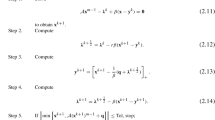Abstract
Mangasarian has shown that the solution of the complementarity problem is equivalent to the solution of a system of nonlinear equations. In this paper, we propose a damped Gauss-Newton algorithm to solve this system, prove that under appropriate hypotheses one gets rapid local convergence, and present computational experience.
Similar content being viewed by others
References
Subramanian, P. K.,Gauss-Newton Methods for the Nonlinear Complementarity Problem, Technical Summary Report No. 2845, Mathematics Research Center, University of Wisconsin-Madison, 1985.
Cottle, R. W., andDantzig, G.,Complementary Pivot Theory of Mathematical Programming, Linear Algebra and Its Applications, Vol. 1, pp. 103–125, 1968.
Chung, S. J.,A Note on the Complexity of LCP: The LCP Is NP-Complete, Journal of Optimization Theory and Applications, Vol. 60, pp. 393–399, 1989.
Lemke, C. E.,Bimatrix Equilibrium Points and Mathematical Programming, Management Science, Vol. 11, pp. 681–689, 1965.
Cryer, C. W.,The Solution of a Quadratic Programming Problem Using Systematic Overrelaxation, SIAM Journal on Control, Vol. 9, pp. 385–392, 1971.
Cottle, R. W., Golub, G. H., andSacher, R. S.,On the Solution of Large Structured Complementarity Problems, Applied Mathematics and Optimization, Vol. 4, pp. 347–363, 1978.
Mangasarian, O. L.,Solution of Symmetric Linear Complementarity Problems by Iterative Methods, Journal of Optimization Theory and Applications, Vol. 22, pp. 465–485, 1977.
Eaves, B. C.,Homotopies for Computation of Fixed Points, Mathematical Programming, Vol. 3, pp. 1–22, 1972.
Scarf, H.,The Approximation of Fixed Points of a Continuous Mapping, SIAM Journal on Applied Mathematics, Vol. 22, pp. 1328–1343, 1967.
Scarf, H.,The Computation of Economic Equilibria, Yale University Press, New Haven, Connecticut, 1973.
Robinson, S. M.,Generalized Equations and Their Solutions, Part 1: Basic Theory, Mathematical Programming Study, Vol. 10, pp. 128–141, 1979.
Robinson, S. M.,Strongly Regular Generalized Equations, Mathematics of Operations Research, Vol. 5, pp. 43–62, 1980.
Robinson, S. M.,Generalized Equations and Their Solutions, Part 2: Application to Nonlinear Programming, Vol. 19, pp. 200–221, 1982.
Robinson, S. M.,Generalized Equations, Mathematical Programming: The State of the Art, Edited by A. Bachem, M. Grötschel, and B. Korte, Springer-Verlag, Berlin, Germany, 1982.
Josephy, N. H.,Newton's Method for Generalized Equations and the PIES Energy Model, PhD Thesis, Department of Industrial Engineering, University of Wisconsin-Madison, 1979.
Hogan, W. W.,Energy Policy Models for Project Independence, Computers and Operations Research, Vol. 2, pp. 251–271, 1975.
Mangasarian, O. L.,Equivalence of the Complementarity Problem to a System of Nonlinear Equations, SIAM Journal on Applied Mathematics, Vol. 31, pp. 89–92, 1976.
Robinson, S. M.,Newton's Method for a Class of Nonsmooth Functions, Working Paper, Department of Industrial Engineering, University of Wisconsin-Madison, 1988.
Han, S. P., Pang, J. S., andRangaraj, N.,Globally Convergent Methods for Nonsmooth Equations, Working Paper, Department of Mathematical Sciences, Johns Hopkins University, 1989.
Pang, J. S., andGabriel, S. A.,NE/SQP: A Robust Algorithm for the Nonlinear Complementarity Problem, Working Paper, Department of Mathematical Sciences, Johns Hopkins University, 1991.
Grippo, L., Lampariello, F., andLucidi, S.,A Monotone Line Search Technique for Newton's Method, SIAM Journal on Numerical Analysis, Vol. 23, pp. 707–716, 1986.
Ferris, M., andLucidi, S.,Globally Convergent Methods for Nonlinear Equations, Technical Report No. 1030, Department of Computer Sciences, University of Wisconsin-Madison, 1991.
Ortega, J. M., andRheinboldt, W. C.,Iterative Solution of Nonlinear Equations in Several Variables, Academic Press, New York, New York, 1970.
Ortega, J. M.,Numerical Analysis: A Second Course, Academic Press, New York, New York, 1972.
Garcia-Palomares, U. M., andMangasarian, O. L.,Superlinearly Convergent Quasi-Newton Algorithms for Nonlinearly Constrained Optimization Problems, Mathematical Programming, Vol. 11, pp. 1–13, 1976.
Kostreva, M. M.,Cycling in Linear Complementarity Problems, Mathematical Programming, Vol. 16, pp. 127–130, 1979.
Colville, A. R.,A Comparative Study on Nonlinear Programming Codes, Scientific Report No. 320-2949, IBM New York, 1968.
Kojima, M.,Computational Methods for Solving the Nonlinear Complementarity Problem, Keio Engineering Reports, Vol. 27, pp. 1–41, 1974.
Subramanian, P. K.,A Dual Exact Penalty Formulation for the Linear Complementarity Problem, Journal of Optimization Theory and Applications, Vol. 58, pp. 525–538, 1988.
Author information
Authors and Affiliations
Additional information
Communicated by O. L. Mangasarian
The author would like to thank Professor Michael Ferris for pointing out a flaw in one of the proofs in an earlier preprint of this paper (Ref. 1). He is grateful to Professor Olvi Mangasarian for bringing to his attention additional references relevant to the material in this paper, and for his suggestions which resulted in a greatly improved presentation.
Rights and permissions
About this article
Cite this article
Subramanian, P.K. Gauss-Newton methods for the complementarity problem. J Optim Theory Appl 77, 467–482 (1993). https://doi.org/10.1007/BF00940445
Issue Date:
DOI: https://doi.org/10.1007/BF00940445



